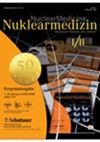[Evaluation of radionuclide impurities in several radiopharmaceuticals].
IF 1
4区 医学
Q4 RADIOLOGY, NUCLEAR MEDICINE & MEDICAL IMAGING
引用次数: 2
Abstract
PURPOSE Revisions to German radiation protection laws have resulted in updated limit values, which could affect the unrestricted release of waste produced by nuclear medicine therapy. In addition, signs of long-lived concomitant nuclides in 153Sm and 223Ra radiopharmaceuticals have been seen in the past. Therefore, the goal of this article was to analyze the radionuclidic purity of selected radiopharmaceuticals. METHOD 48 samples from 12 different radiopharmaceuticals were examined. A high purity germanium semiconductor detector (HPGe detector) was used for the qualitative and quantitative evaluation of concomitant nuclides. RESULTS Various europium isotopes were identified in 90Y-citrate, 153Sm-Quadramet, 166Ho-QuiremSpheres, and 169Er-erbium citrate, with the greatest amount being found in 153Sm (7.0 ppm (152Eu), 8.4 ppm (154Eu), and 2.1 ppm (155Eu)). 169Yb was the most significant impurity in 169Er (513 ppm). In the case of 177Lu radiopharmaceuticals, there was a significant difference in the 177mLu content (0.8 ppm vs. 0.0024 ppm) between two different manufacturers. No concomitant nuclides could be found within the detection limits in the case of 90Y spheres, 223Ra, and 225Ac. CONCLUSION The limit values for unrestricted release are exceeded manyfold in the case of the identified concomitant nuclides. As a result, alternative release procedures (extension of the decay time, specific release, release in the individual case) or transfer to collection facilities must be considered. Technical methods for reducing or preventing impurities could also be a possible solution. Consequences for patient radiation exposure were able to be ruled out.[几种放射性药物中放射性核素杂质的评价]。
德国辐射防护法律的修订导致了最新的极限值,这可能影响核医学治疗产生的废物的无限制释放。此外,过去曾在153Sm和223Ra放射性药物中发现过伴随核素的长寿命迹象。因此,本文的目的是分析选定的放射性药物的放射性核素纯度。方法对12种不同放射性药物的48份样品进行检测。采用高纯锗半导体检测器(HPGe检测器)对伴随核素进行定性和定量评价。结果在90y -柠檬酸盐、153Sm- quadramet、166Ho-QuiremSpheres和169er -柠檬酸铒中发现了不同的铕同位素,其中153Sm (7.0 ppm (152Eu)、8.4 ppm (154Eu)和2.1 ppm (155Eu)中发现的铕同位素最多。169Er (513 ppm)中杂质含量最高的是169Yb。以177Lu放射性药物为例,两家不同制造商的177mLu含量(0.8 ppm vs. 0.0024 ppm)存在显著差异。在90Y球、223Ra球和225Ac球的检测限内未发现伴生核素。结论所检出的伴生核素超过其无限制释放限量数倍。因此,必须考虑其他释放程序(延长衰变时间、特定释放、个别释放)或转移到收集设施。减少或防止杂质的技术方法也是一种可能的解决方案。对病人辐射暴露的后果可以排除。
本文章由计算机程序翻译,如有差异,请以英文原文为准。
求助全文
约1分钟内获得全文
求助全文
来源期刊
CiteScore
1.70
自引率
13.30%
发文量
267
审稿时长
>12 weeks
期刊介绍:
Als Standes- und Fachorgan (Organ von Deutscher Gesellschaft für Nuklearmedizin (DGN), Österreichischer Gesellschaft für Nuklearmedizin und Molekulare Bildgebung (ÖGN), Schweizerischer Gesellschaft für Nuklearmedizin (SGNM, SSNM)) von hohem wissenschaftlichen Anspruch befasst sich die CME-zertifizierte Nuklearmedizin/ NuclearMedicine mit Diagnostik und Therapie in der Nuklearmedizin und dem Strahlenschutz: Originalien, Übersichtsarbeiten, Referate und Kongressberichte stellen aktuelle Themen der Diagnose und Therapie dar.
Ausführliche Berichte aus den DGN-Arbeitskreisen, Nachrichten aus Forschung und Industrie sowie Beschreibungen innovativer technischer Geräte, Einrichtungen und Systeme runden das Konzept ab.
Die Abstracts der Jahrestagungen dreier europäischer Fachgesellschaften sind Bestandteil der Kongressausgaben.
Nuklearmedizin erscheint regelmäßig mit sechs Ausgaben pro Jahr und richtet sich vor allem an Nuklearmediziner, Radiologen, Strahlentherapeuten, Medizinphysiker und Radiopharmazeuten.

 求助内容:
求助内容: 应助结果提醒方式:
应助结果提醒方式:


